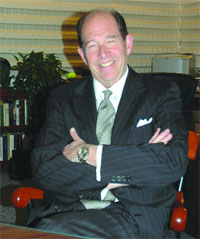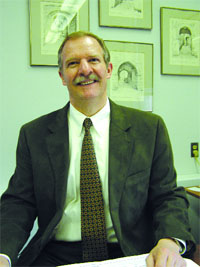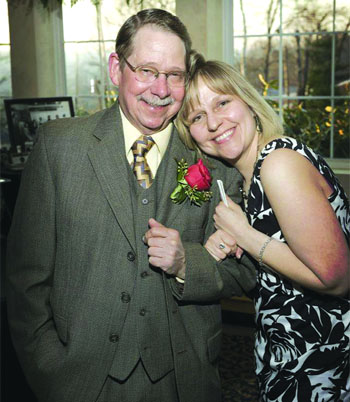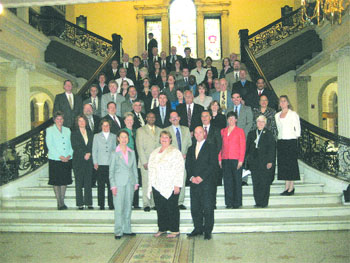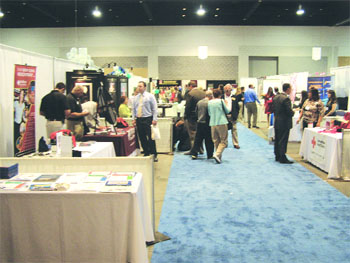When asked about his grandfather, Robert Samble Jr. started by pointing.
Thats him, he said, gesturing toward a framed photograph sitting on a shelf in his crowded office. Somewhat faded by time, the image is of a man sitting behind the wheel of a delivery truck bearing the name Belmont Laundry, circa 1915. Thats Harry Samble
he started all this with grandma.
Thats her there, he continued, pointing to another picture, this one on a higher shelf. She ran it for years with my father after grandpa died.
And thats my father there, he went on, pointing to a picture of a man in uniform standing next to a P-47 Thunderbolt fighter plane. Thats from his days in the Army Air Corps during World War II.
When businesses stay in the same family for several generations, there are usually lots of old photographs on walls, atop credenzas, or in desk drawers, and so it is with the Western Mass. Entrepreneurship Hall of Fames Class of 2008. And as the saying goes, they speak a thousand words.
Barbara Meunier has a favorite picture of her father, Rupprecht Scherff, who ran the Fort restaurant in downtown Springfield for more than 40 years until his death in 1996. The picture in question shows him in one of the dining rooms, where one would usually find him, shaking up some cherries jubilee tableside.
He was always working
always, said Meunier, who now manages the Fort, known to some as the Student Prince, along with her brothers, Rudi and Peter Scherff. And there is now a third generation at work, she noted, adding that her son, Michael, is kitchen manager, and Rudis son (also named Rudi) recently took home his first paycheck for work in the deli.
There is a fourth generation now working at Belmont Laundry Sambles sons, Matt and Derek, have lead roles and a fifth generation continues to market Absorbine liniment and other products at W.F. Young, which was started by Wilbur Fenton Young in 1892. The company, and the Young family, have several pictures of the founder, including one with his signature followed by the letters P, D, and F. Apparently, Wilburs father, Charles, didnt think much of his sons decision to start a company making liniment for horses and, later, humans. As a condition for granting a $500 loan to help finance an expansion of the venture, the elder Young stipulated that his son pronounce himself in all advertising as Pas Darn Fool.
Long-surviving family businesses, old photos, and the stories behind them may be the dominant theme for the Class of 2008, but there are other intriguing stories in this roster of inductees, the ninth to be enshrined.
Baystate Health is being inducted to recognize an entrepreneurial spirit that has manifested itself in many ways, said Tom Goodrow, vice president of Economic and Business Development at Springfield Technical Community College, which created the Hall of Fame. These include many new ventures in recent years, including the DAmour Center for Cancer Care, one of many new developments on the north end of Main Street, and a $239 million expansion, dubbed the Hospital of Tomorrow, due to be started this fall.
There are also the entrepreneurial exploits of Art Jacobson who founded Olympic Manufacturing Group in Agawam, now called OMG Inc., and later founded Mr. Shower Door and the individuals now at the helm at OMG.
The Class of 2008 was introduced at a reception staged May 22 at the Colony Club, and the new inductees will be honored at the annual Hall of Fame dinner on Oct. 2 at the Log Cabin Banquet and Meeting House.
Proceeds from that event will benefit the many entrepreneurship programs at STCCs Andrew M. Scibelli Enterprise Center (SEC), said Goodrow. These include the YES (Young Entrepreneurial Scholars) program, which serves more than 1,000 young men and women in two dozen area high schools, as well as the Community Foundation of Western Mass. student business incubator in the SEC, which hosts up to nine fledgling businesses.
Heres a look at the Class of 2008.
Belmont Laundry (the Samble Family)
Before moving on to that truck, Harry Samble picked up and dropped off laundry on his bicycle and, later, a horse and buggy.
In those days, his service was called wet wash, said Robert Samble, noting that his grandparents would pick up laundry, wash it, and bring it back to the customer wet, to be dried on a line outside. This line of work has evolved considerably over the years, he continued, adding that Belmont now has a fleet of trucks and more than 50 employees, and handles more than 1,000 commercial accounts in a service area stretching from Newport, R.I. to Pittsfield.
How it arrived at this state is a story of perseverance, vision, and dedication to customer service, he explained. To emphasize this point, he stopped at a pair of recently cleaned uniform pants soon to be returned to a commercial client. Turning the waist back, he revealed a radio frequency identification (RFID) tag implanted within. Each item has one, said Samble, to ensure that every shirt, pair of pants, physicians coat, or commercial floor mat goes where its supposed to go.
The big outfits dont do this, because its expensive and they dont want to spend that kind of money on customer service, he said, adding that Belmont has been taking such steps since Harry and Corrine Samble set up shop in 1907 in a barn on the location where the headquarters building still stands today.
Harry Samble died when his son, Robert, was only 14, pressing the second generation of the family into a large role within the business at an early age. For many years, Robert Samble and his mother ran the business, along with one of Harry Sambles brothers, who was later bought out.
Robert Samble Jr. is a little sketchy on some of the history, because he never met his grandfather and his father died in 1967, when Robert was just 14. It was then that Roberts mother, Dorothy, who had not been involved in the business at all while her husband was alive, essentially took over and kept the doors open.
If it wasnt for her, we wouldnt be here today, said Robert, adding that, in 1973, his mother was able to convince him to change careers (he had been a refractory mason) and join the family business.
Since then, he has orchestrated significant growth the company has added locations in Agawam, West Springfield, Longmeadow, and a second store in Springfield and diversification. Hes been joined in the business by sons Matthew, now project manager, and Derek, the dry-cleaning division manager, and stepdaughter April Caruso, who is supervisor of counter staff.
Commercial work, which now accounts for roughly 75% of Belmonts business, remains strong, said Samble, but the retail side of the ledger has been soft in recent years, a trend he attributes to more-casual dress in the workplace, among other factors.
People arent dressing up like they used to, he explained, adding quickly that the company will persevere, whether that trend changes or not. It has endured for 101 years because its been able to add new wrinkles or iron them out, as the case may be.
The Fort Restaurant
There are a few pictures of Rupprecht Scherff on the walls of the Fort, providing a continuing presence for the individual credited with making the restaurant a Springfield institution and popular stop for the business community.
But it is the work of two generations, and now a third, that has enabled the venue to persevere for 73 years, a very rare feat in the challenging restaurant business.
The Fort is known for many things, including its two names Student Prince, taken from a Sigmund Romberg operetta about student life in Heidelberg, and the Fort, the name given the main dining room, in recognition of the fort John Pynchon built on the site in 1660 and also an extensive collection of beer steins, its veal shank, scrod, and Roquefort salad dressing.
It all started back in 1935 with Paul Schroeder, a native of Germany and cigar maker by trade. After working at several area cigar factories, he took a job as the housemaster of the Springfield Turnverein, a German club that continued to serve its members libations during Prohibition. After repeal of the Eighteeth Amendment in 1933, Schroeder saw an opportunity to start his own business, and did so, partnering with Erna Sievers in the Student Prince restaurant on Fort Street.
Rupprecht Sherff would eventually take a job there in 1949. He came to the U.S. from Germany years earlier, at the behest of Robert Jarhling, owner of the Highland Hotel in Springfield, whom Scherff had impressed while he waited on Jarhling and his wife when they were visiting Bremen. Scherff worked at the Highland for many years and later fought in World War II before coming to the Student Prince. He started in the kitchen and was eventually asked to manage the restaurant. When Sievers died in 1961, she left the establishment to Scherff and another employee, Tante Grete, whom Scherff bought out in 1971 to assume sole ownership.
Barbara Meunier said she and her brothers practically grew up in the restaurant, eventually handling every job in it. Rudi started when he was 8, and was officially on the payroll at age 12. Barbara, meanwhile, started at 14. Neither thought they would make the Fort their career, but after trying other pursuits Rudi practiced law in Springfield for several years they gravitated back to Fort Street.
Today, they split the various responsibilities involved with day-to-day operations Meunier handles most office duties; Peter, who has an MBA, handles most financial aspects of the business; and Rudi takes care of the kitchen and the menu and continue many traditions started by their father, such as Octoberfest, Mayfest, a wild game festival, and elaborate decorations for the holidays.
Theyve also brought the third generation into the business, which, says Meunier, has the same work ethic as the man in all the pictures.
Baystate Health
Andrew Scibelli, president emeritus of STCC and chair of the steering committee for this years induction ceremonies, acknowledged that Baystate Health is a different kind of selection for the Hall of Fame.
Rather than acknowledging one individual or several members or generations of one family, the selection of Baystate constitutes recognition of an entrepreneurial philosophy that pervades the system and its more than 10,000 employees, said Scibelli.
Theyre not just running a hospital there, he continued. Theyre being entrepreneurial in every aspect of that word; theyre looking for opportunities, theyre taking risks in some cases, and theyre taking steps that will benefit themselves and the community they serve.
Elaborating, he said there have been many examples of this over the years, and especially the past decade or so. Endeavors include a number of ventures on Main Street, several blocks from Baystate Medical Center, with most of them involving former mill complexes that were either rehabbed or replaced with new construction.
These include the DAmour Center for Cancer Care, the regions only free-standing, multi-disciplinary cancer treatment facility, opened in 2002, and the Pioneer Valley Life Sciences Institute, a joint venture between Baystate Health and UMass Amherst that was created in 2004 to develop new approaches for the diagnosis and treatment of disease.
Other examples include the expansion of the health system to include Baystate Franklin Medical Center and Baystate Mary Lane Hospital, and the systems involvement in the creation of the for-profit health maintenance organization Health New England, in which it still owns a majority interest.
The most recent, and soon to be most visible, example of Baystates entrepreneurial drive is a $239 million expansion project, the Hospital of the Future, a nearly 600,000-square-foot complex that will replace some of the hospitals older facilities with new, state-of-the-art patient-care areas that administrators say will directly address the needs of an aging population.
The expansion is perhaps the largest in the history of the system, which can trace its roots back to 1883 and the opening of Springfield Hospital. In 1974, what was then known as Springfield Hospital Medical Center merged with its neighbor, Wesson Womens Hospital, to create the 672-bed Medical Center of Western Mass. In 1976, this entity merged with Wesson Memorial Hospital, located about two miles away. The merger established Baystate Medical Center, then the second-largest hospital in New England, with 1,036 beds.
In 1983, Baystate Medical Center was reorganized into three separate corporations: Baystate Health Systems, the parent corporation now renamed Baystate Health; Baystate Medical Center; and a for-profit corporation known as Baystate Diversified Health Services.
The Baystate Health family has grown significantly since its inception. In 1986, Baystate Franklin Medical Center in Greenfield joined Baystate Health; in 1991, Baystate Mary Lane Hospital in Ware joined the health system. In 1996, the Visiting Nurse Association & Hospice of Pioneer Valley, now renamed the Baystate Visiting Nurse Association & Hospice, also became a member of Baystate Health.
Through all the additions and name changes, the system has been consistently entrepreneurial in its approach to doing business and serving the community, said Baystate President and CEO Mark Tolosky.
In the fast and ever-changing health care environment, we must be nimble and responsive to the needs of our patients and our communities, and assure them that we are stewards of all of our resources, and with that comes the need to be visionaries and risk takers, he said. One example of our entrepreneurial spirit at Baystate Health aligned with vision and risk relates to North Main Street in Springfield.
Just over 10 years ago, the land sat silent, with vast, empty buildings once home to robust manufacturers of hand tools and much more, he continued. The leadership of Baystate Health saw opportunity, and we invested $125 million to develop this Northern Edge Medical campus. Our lead role has led to significant private investment in the area. Now, we see a vibrant complex with health care at its core and with other businesses benefiting from the spin-off effects of this development.
The vision we had became a reality and theres more to come.
W.F. Young
Wilbur Young was selling pianos in the early 1890s, and doing rather well at it, when he started looking for a different, more entrepreneurial career opportunity.
He found one through his love of horses and some encouragement from his new bride, Mary Ida. The product that Wilbur developed, and that the couple made in a tub in their farmhouse kitchen, would come to be called Absorbine Veterinary Liniment. A blend of herbs and essential oils, the liniment would keep a horse from going lame while gently reducing swelling and stiffness.
More than 116 years later, the liniment remains the flagship brand marketed by W. F. Young Inc., a company credited with coining the phrase athletes foot and, over the years, developing a wide array of health care products. Today, the company, which, after spending most of its existence in downtown Springfield, moved to East Longmeadow in 2000, is a global marketer of products for humans and animals.
The company, which started small, really began to grow when farmers discovered that Absorbine Liniment worked on humans, as well, said Tyler Young, its CEO, president, and fourth-generation manager. Using the original formula as a basis with some changes and
efinements, Wilbur created a liquid for human use, called it Absorbine Jr. Antiseptic Liniment, and brought it to the marketplace in 1903.
As demand increased, the original manufacturing operation in Meriden, Conn. proved insufficient, said Tyler Young, adding that his great-grandfather went to his great-great-grandfather and secured a loan and its unusual condition. The company grew steadily over the years, adding some celebrity spokespeople Hall of Fame pitcher Walter Johnson and Triple Crown champion Secretariats trainer, Lucien Lauren while also adding athletes foot to the lexicon in the 1930s.
The company typically introduces between five to 10 new products a year, said Tyler Young, adding that recent additions include DuraGuard® and Bug Block® insect repellents for horses, the innovative Stall Safe® brand disinfectant and sanitizer for stables and stalls, and Myoplast®, an amino-acid supplement which helps provide strength and stamina in horses while supporting lean muscles.
More than a decade ago, the company transitioned out of manufacturing and now bills itself as a virtual marketing company, Young continued. Production of the entire network of brands is outsourced throughout the U.S.; the operations department manages production from the companys East Longmeadow headquarters. After 80-plus years in Springfield, the company moved to its new offices in the East Longmeadow Industrial Park in 2000.
Art Jacobson and OMG Inc.
He called it the roofle.
Thats the name Art Jacobson came up with for a new product he contrived back in 1981 to suit the needs of one of his clients.
At the time, Jacobson was a manufacturers representative for companies that made bolts, rivets, and screw-machine parts, among other things, and selling to companies like Hamilton Standard, Pratt & Whitney, and Electric Boat. He was calling on a client that made commercial roofing systems when a discussion ensued that would eventually lead to what Jacobson called a fluke of a business, and what has become one of the regions most intriguing entrepreneurial success stories.
I was selling him long screws to fasten his roofing down to concrete decks, Jacobson recalled. He said that if I came up with a different kind of fastener, like a long toggle bolt, he could use it to fasten roofing down to lightweight concrete decks where a screw wouldnt work.
One of the companies Jacobson represented made long bolts that he sold to a wooden-rail manufacturer. He borrowed some, took them to a hardware store in Springfield, and put toggle wings and large washers on them. He then took them back to his roofing-industry client, who pronounced them exactly what he was looking for.
Thus, the Olympic Manufacturing Group was born, only it would be several more years before it would be called that and before it did any manufacturing.
After securing a patent for his roof toggle, or roofle, Jacobson took out an ad in a national roofing trade publication which touted the product and its potential. And calls started coming in. Still at his sales job and with no inventory on hand, Jacobson started having the roofle made for him to fill those orders, and, in so doing, moving more quickly than most entrepreneurs would in taking a venture off the ground.
I found myself getting into a business I really knew nothing about, he explained. Most entrepreneurs will investigate to the hilt or work on a product for six months or a year before deciding whether to take it to the market. Not me; I sort of fell into it.
Fast-forwarding somewhat, Jacobson said he would have long bolts shipped to him, add the toggles and other features that converted them into roofles, and run back and forth to Bradley International Airport to ship them out. Eventually, he and his wife, Esther, rented out 250 square feet of space to operate the venture, and by late 1982, they had decided to go into business together.
Within a few more years, Olympic would become a manufacturer of roofing fasteners, and by 1985 it would be No. 1 in the industry.
Jacobson said the key to the companys steady growth within the Agawam Industrial Park was hiring the right people, individuals such as Hugh McGovern, who would later become president of Olympic (later to be called OMG), after Jacobson sold it; Dan Murphy, who eventually would become president of a succession of larger owners of OMG; and Tom Wagner, OMGs senior vice president.
We succeeded because I surrounded myself with people better than me, he explained. They took the company to places I couldnt.
Jacobson described his sale of Olympic in 1994 as the quintessential win-win, and both parties would go on to write more success stories.
After chasing the grandkids around for several years, as he put it, Jacobson started Mr. Shower Door in 2005. Hes tripled sales since them, and now has three locations.
Meanwhile, OMG continues to grow, organically and through acquisition. The most recent example was the purchase and assimilation of Illinois Tool Works (ITW), Buildexs roofing business segment, which is now known as OMG West.
Today, total sales are approaching $150 million. Not bad for a fluke of a business.
George OBrien can be reached at[email protected]



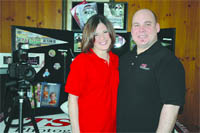

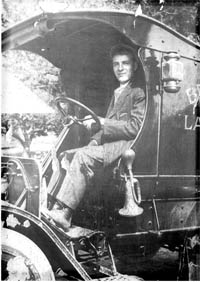

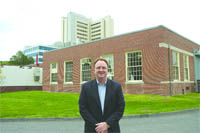

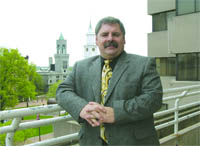


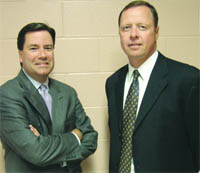
 Shane Bajnoci says there’s some science associated with sustainable forestry, but it’s also a bit of an art. “It’s a forever-changing job, and I’m always trying to explain it to people so they understand what we’re doing,” he said, noting that it all boils down to managing a resource — the region’s large, but not limitless, supply of forest land — so that the needs of current and future generations can be met. Bajnoci started his career at Cowls Land and Lumber Co. 12 years ago after earning a bachelor’s degree in Forest Conservation at UMass Amherst, and since then, his responsibilities have only grown. He leads a crew of 14 that harvests and manufactures some 2 million board feet of logs and lumber per year, while also managing thousands of acres of land and their boundaries in nearly 30 towns across the region. His post also requires completing countless pages of state and federal paperwork, drafting management plans for the year, contracting with local loggers and truckers, and cultivating a small Christmas tree farm. Bajnoci also sits on several industry-related boards, including the Mass. Wood Producers Assoc., the Mass. Assoc. of Professional Foresters, and the Pelham Forest Conservation Committee. But despite this workload, Bajnoci added another bullet to his resume this past year, leading Cowls’ participation in the Inaugural American Woodcock Initiative. The business joined forces with the Mass. Division of Fish and Wildlife, the Ruffed Grouse Society, and the Wildlife Management Institute to launch the program, which focuses on habitat-management efforts that can curb the decline of various wildlife populations in addition to the woodcock, such as the New England cottontail, wood turtle, and gold-winged warbler. Bajnoci has incorporated initiatives that benefit these species into his annual plans, and, in 2007, garnered a Forest Stewardship Award for his company from the International Assoc. of Fish and Wildlife Agencies. “I hope others can use us as a model for habitat management,” said Bajnoci, “and I want to create more habitats that would support certain species, especially birds. It’s a lot of work, but it’s also my passion to do long-term land management, so I’m glad I have a place to do it.” And while much of his job revolves around cutting down trees, he’s also planting important seeds, and watching them grow. Jaclyn Stevenson
Shane Bajnoci says there’s some science associated with sustainable forestry, but it’s also a bit of an art. “It’s a forever-changing job, and I’m always trying to explain it to people so they understand what we’re doing,” he said, noting that it all boils down to managing a resource — the region’s large, but not limitless, supply of forest land — so that the needs of current and future generations can be met. Bajnoci started his career at Cowls Land and Lumber Co. 12 years ago after earning a bachelor’s degree in Forest Conservation at UMass Amherst, and since then, his responsibilities have only grown. He leads a crew of 14 that harvests and manufactures some 2 million board feet of logs and lumber per year, while also managing thousands of acres of land and their boundaries in nearly 30 towns across the region. His post also requires completing countless pages of state and federal paperwork, drafting management plans for the year, contracting with local loggers and truckers, and cultivating a small Christmas tree farm. Bajnoci also sits on several industry-related boards, including the Mass. Wood Producers Assoc., the Mass. Assoc. of Professional Foresters, and the Pelham Forest Conservation Committee. But despite this workload, Bajnoci added another bullet to his resume this past year, leading Cowls’ participation in the Inaugural American Woodcock Initiative. The business joined forces with the Mass. Division of Fish and Wildlife, the Ruffed Grouse Society, and the Wildlife Management Institute to launch the program, which focuses on habitat-management efforts that can curb the decline of various wildlife populations in addition to the woodcock, such as the New England cottontail, wood turtle, and gold-winged warbler. Bajnoci has incorporated initiatives that benefit these species into his annual plans, and, in 2007, garnered a Forest Stewardship Award for his company from the International Assoc. of Fish and Wildlife Agencies. “I hope others can use us as a model for habitat management,” said Bajnoci, “and I want to create more habitats that would support certain species, especially birds. It’s a lot of work, but it’s also my passion to do long-term land management, so I’m glad I have a place to do it.” And while much of his job revolves around cutting down trees, he’s also planting important seeds, and watching them grow. Jaclyn Stevenson
 Rob Anthony says they’re the best three days of the year. He was referring to the Children’s Miracle Network radiothon that he and others at WMAS radio — which he now serves as program manager, ‘afternoon host,’ and operations manager — have been part of for the past seven years. This is an intense, emotional, rewarding three days that raise money for Baystate Children’s Hospital (more than $200,000 during the 2008 edition) and each year creates memories that last a lifetime. Like 11-year-old Devon Roy’s speech on Rosa Parks. It was perhaps the most unforgettable moment of this year’s radiothon, staged just a few weeks ago. Roy was supposed to deliver that address at her Greenfield school’s history fair, but she had to be in the children’s hospital instead because of her respiratory illness. So Anthony got the idea to have her read the speech over the air, with the entire school listening in the auditorium. “There wasn’t a dry eye on the play deck,” said Anthony, referring to the area that serves as a broadcast studio for the radiothon, and including himself in that company. That’s one of the occupational hazards of the radiothon, he said, adding that he and others from the station often get emotional as they’re broadcasting, and have no regrets about doing so. “It just shows you’re human.” Anthony says the radiothon is just one reason why he says of his job, “calling it work is a bit of a stretch.” In short, he loves music, and thoroughly enjoys being on the air. In fact, he left another station in the area for his first job at WMAS, at a considerable reduction in salary, because it afforded him the chance to get behind the microphone. He’s still there, working the 3 to 7 p.m. shift, while also helping to set a strategic plan for the station, and charting an aggressive philanthropic course that includes work to assist groups ranging from the children’s hospital to the Children’s Study Home. An avid sports fan and NASCAR follower (he’s a Dale Earnhardt Jr. devotee), Anthony must balance these interests and his work in radio with family, and especially his 8-month-old daughter, Kaitlynn. The ’08 radiothon was the first since her birth, he noted, and this juxtaposition made those three days even more poignant — and special. George O’Brien
Rob Anthony says they’re the best three days of the year. He was referring to the Children’s Miracle Network radiothon that he and others at WMAS radio — which he now serves as program manager, ‘afternoon host,’ and operations manager — have been part of for the past seven years. This is an intense, emotional, rewarding three days that raise money for Baystate Children’s Hospital (more than $200,000 during the 2008 edition) and each year creates memories that last a lifetime. Like 11-year-old Devon Roy’s speech on Rosa Parks. It was perhaps the most unforgettable moment of this year’s radiothon, staged just a few weeks ago. Roy was supposed to deliver that address at her Greenfield school’s history fair, but she had to be in the children’s hospital instead because of her respiratory illness. So Anthony got the idea to have her read the speech over the air, with the entire school listening in the auditorium. “There wasn’t a dry eye on the play deck,” said Anthony, referring to the area that serves as a broadcast studio for the radiothon, and including himself in that company. That’s one of the occupational hazards of the radiothon, he said, adding that he and others from the station often get emotional as they’re broadcasting, and have no regrets about doing so. “It just shows you’re human.” Anthony says the radiothon is just one reason why he says of his job, “calling it work is a bit of a stretch.” In short, he loves music, and thoroughly enjoys being on the air. In fact, he left another station in the area for his first job at WMAS, at a considerable reduction in salary, because it afforded him the chance to get behind the microphone. He’s still there, working the 3 to 7 p.m. shift, while also helping to set a strategic plan for the station, and charting an aggressive philanthropic course that includes work to assist groups ranging from the children’s hospital to the Children’s Study Home. An avid sports fan and NASCAR follower (he’s a Dale Earnhardt Jr. devotee), Anthony must balance these interests and his work in radio with family, and especially his 8-month-old daughter, Kaitlynn. The ’08 radiothon was the first since her birth, he noted, and this juxtaposition made those three days even more poignant — and special. George O’Brien

